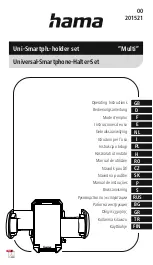
Chapter 3 Operating the ETC II
Using the ETC II
16
ETC II Network Communicator
usage. When using non-standard communication protocols, all messages
are routed to the COM4 port.
Port
COM5
Unused
COM4 Master +
COM5 Serial
COM4 Master +
COM5 IP-Link
COM4 Slave +
COM5
COM4 Master 1-247
1-32
216-247
-
COM5
-
33-247
1-215
1-247
The second option uses the device routing table. It is available starting with
V21.5.4. The routing table explicitly identifies the target network for every
individual device connected to the ETC II. For serial and wireless devices, it
specifies a serial port to which the device network is connected. For Ethernet
devices, it allows you to specify the device’s IP address on the Ethernet
network.
To use the device routing table:
1.
Specify a routing path for every device connected to the ETC II
gateway. Specify the IP address for every Internet device and the target
serial port for every serial and wireless device connected to the ETC II.
See
Configuring Device Routing Table
in Chapter 5 for information on
programming the device routing table.
2.
Enable the routing table in your ETC II via the ETC II Gateway Options
Setup (see
Configuring Gateway Options
in Chapter 5).
Shared Device Access
Shared device access allows several clients to simultaneously access the
slave device’s registers either for reading or writing. It is enabled by the
default, so different clients can poll registers in the same device without
collisions that are normally resolved by the ETC II.
However, accessing a file in the device at the time when another client is
reading data from that or another file in the same device could destroy file
buffers such that both clients may receive corrupted data.
To avoid possible collisions, the ETC II offers you two options:
1.
First, you can entirely disable shared device access so that the ETC II
rejects any additional requests addressed to a device that is being
accessed by another client. In this event, the ETC II returns an
exception response with the error code 10 “Gateway is busy” until the
first client closes the session or points to a different device. See
Configuring Gateway Options
in Chapter 5 on how to enable or disable
shared device accesses in your ETC II.
2.
The second option uses the device routing table for defining a device-
sharing policy. Shared device access should be enabled in the ETC II
(see
Configuring Gateway Options
in Chapter 5), and device-sharing
rules should be selected for each individual device. In this event, only
protected registers, which are defined by a selected access rule, are
blocked for shared accesses while others are always available for all
clients. See
Configuring Device Routing Table
in Chapter 5 for
information on programming the device-routing table.
ETC II Network Applications
Transparent Gateway
The ETC II normally provides a means for transparent exchange of
messages between master Internet and serial client applications, and slave
serial or wireless devices.
The ETC II can manage up to eight concurrent sessions between master
stations and slave devices. Each connection is fully transparent for the
master. The ETC II forwards client requests to target devices, and then
returns responses to the master application, maintaining all timing
regulations required by the protocol. The serial networks are accessed in a
queued manner that prevents possible collisions.
















































